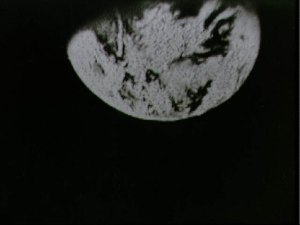 I am not generally one to commemorate a holiday with a themed post. Nevertheless, I thought it would be an appropriate occasion to discuss the only Apollo mission to fly on Christmas – the 1968 lunar orbital mission of Apollo 8. (Left: the first view of the Earth taken by Apollo 8 on its way to the moon. 1968.)
I am not generally one to commemorate a holiday with a themed post. Nevertheless, I thought it would be an appropriate occasion to discuss the only Apollo mission to fly on Christmas – the 1968 lunar orbital mission of Apollo 8. (Left: the first view of the Earth taken by Apollo 8 on its way to the moon. 1968.)
I’ve mentioned before that the sheer speed at which NASA accomplished the steps leading to and culminating in a lunar landing is one of the fascinating aspects that led me to study the era in the first place. The methods of choosing, launching, and bringing home the astronauts were all determined based on what could be done fastest and easiest, with the goal of staying one step ahead of the Soviets in the background.
The first flight to the moon was no different. Apollo 8’s lunar orbital flight was not in the initial Apollo schedule. It was undertaken, like so many aspects of the early space program, as a crash response to an immediate need. The story of its origin is as interesting as the flight itself.
When the Apollo program began, the missions were planned in such a way that each built on the successes of its predecessor. All flights preceding the lunar landings were designed to test the spacecraft, ensuring there were no problems in flying it, and that its software was in optimal working order.
The Apollo spacecraft is comprised of three sections, each of which had to be tested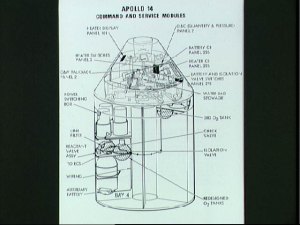 thoroughly before attempting a lunar landing. The Command Module is the portion that houses the astronauts from launch to splashdown, with the exception of the lunar landing. The CM is docked with the Service module, the portion that houses the various gases used for fuel as well as providing the astronauts with air and water. The CM and SM are docked for the duration of the mission until just prior to reentry into the Earth’s atmosphere, and together take the designation of CSM. The Lunar Module (LM) is the spidery looking vehicle that took two astronauts to the surface of the moon and back. (Pictured: a schematic breakdown of the Apollo CSM.)
thoroughly before attempting a lunar landing. The Command Module is the portion that houses the astronauts from launch to splashdown, with the exception of the lunar landing. The CM is docked with the Service module, the portion that houses the various gases used for fuel as well as providing the astronauts with air and water. The CM and SM are docked for the duration of the mission until just prior to reentry into the Earth’s atmosphere, and together take the designation of CSM. The Lunar Module (LM) is the spidery looking vehicle that took two astronauts to the surface of the moon and back. (Pictured: a schematic breakdown of the Apollo CSM.)
To simply the steps leading to the lunar landing, each mission was designated by a letter to reflect the progress of the overall program. Once the prime objective of one mission was achieved, the next mission would work towards the goals of the next in the series.
The A mission was an unmanned test of the Command and Service Module (CSM) in Earth orbit. The B mission remained in Earth orbit, testing the Lunar Module (LM) in addition to the CSM. The C and D missions paralleled the A and B missions with the addition of a crew: C tested the CSM in Earth orbit and D tested the CSM and LM in Earth orbit. The E mission would take Apollo a step closer to the moon, testing the CSM and LM in a high elliptical Earth orbit. The F mission would be the first to go to the moon, testing the CSM and LM in lunar orbit with the G mission as the first lunar landing.
Apollo hit a snag, to say the least, in January 1967 when a fire in the spacecraft during pre-launch testing claimed the lives of the Apollo 1 crew. The resulting investigation into the accident as well as NASA policies and management stalled the progress of Apollo. A and B missions resumed, but the manned flights were delayed for over a year and a half.
By mid 1968, Apollo was getting back on track, preparing to begin manned Apollo flights later in the year. The flight schedule was set to resume with a C mission, but beyond that the future didn’t look too promising. The LM was plagued with problems and wouldn’t be ready to fly a D mission as planned in December of 1968. The best NASA could home for was a D mission in early 1969.
But potentially more serous problem arose during the year and a half delay in Apollo – the Soviets were gaining momentum towards their own manned lunar flight.
NASA had arguably overtaken its Soviet counterpart in the mid 1960s. The Gemini program progresses much faster than the Soviet efforts; the latter’s last major achievement had been Alexei Leonov’s extra-vehicular activity (EVA, or spacewalk) which NASA had since surpassed, keeping an astronaut outside the spacecraft longer and giving him a better mobility. In August, the game changed. NASA learned from the CIA that the Soviets had completed an unmanned lunar orbital mission.
The Soviet Zond 5 spacecraft had successfully travelled to the moon and returned safely to Earth. This was a significant mission in itself, but it was also a clear indication that a manned lunar orbital mission was within the Soviet realm of possibilities. This suddenly increased the pressure for Apollo to not only land a man on the moon but to get a man to the moon first.
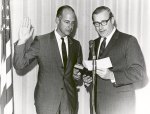 Sensing the mounting pressure, George Low, manager of the Apollo Spacecraft Program Office (ASPO), came up with an elegant solution to the problem of a lagging schedule: keep the planned December launch but change the mission. Leave the problematic LM on the ground and test only the CSM in a circumlunar flight. (Right: George Low is sworn in as NASA Administrator. 1969.)
Sensing the mounting pressure, George Low, manager of the Apollo Spacecraft Program Office (ASPO), came up with an elegant solution to the problem of a lagging schedule: keep the planned December launch but change the mission. Leave the problematic LM on the ground and test only the CSM in a circumlunar flight. (Right: George Low is sworn in as NASA Administrator. 1969.)
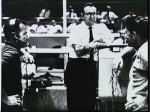 Low and flight director Chris Kraft (left, centre) presented the idea to the director of the Manned Spacecraft Centre (MSC) Bob Gilruth (right). Deke Slayton, former Mercury astronaut who had
Low and flight director Chris Kraft (left, centre) presented the idea to the director of the Manned Spacecraft Centre (MSC) Bob Gilruth (right). Deke Slayton, former Mercury astronaut who had 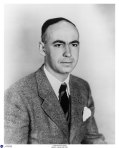 assumed the position as head of the astronaut office after being grounded for a heart condition, was soon brought into the meeting to consider the proposition. To keep the information from the public, only the handful of men who could make the “go/no go” decision knew of the possible lunar mission at this early planning stage.
assumed the position as head of the astronaut office after being grounded for a heart condition, was soon brought into the meeting to consider the proposition. To keep the information from the public, only the handful of men who could make the “go/no go” decision knew of the possible lunar mission at this early planning stage.
Chris Kraft’s successor flight director Gene Kranz was also filled in on the possible new mission. He dubbed the proposed mission ‘Mission X’ for the sake of secrecy, enabling NASA to make sure it was a truly feasible plan before going public.
First and foremost, a decision needed to be made weighing the potential costs against benefits. In short, will the benefits of the mission be substantial enough to negate the risks involved?
A successful lunar mission in the configuration used by Apollo depends on a number of time sensitive manoeuvres. Two and a half hours after liftoff, the lunar portion of the mission begins with a translunar injection manoeuvre, a timed burn of the main engine that puts the spacecraft on a route towards the moon. The result of the burn is an increase in the spacecraft’s velocity to speeds ranging from 25,500 and 35,500 miles per hours. This puts the spacecraft in orbit around the Earth with an apogee (highest point) of 250,000 miles – the distance form the Earth to the moon.
After this translunar burn, the spacecraft enters the phase known as translunar coast (TLC). It takes three days for the spacecraft to cover the 250,000-mile journey. Along the way, any number of smaller burns are made to trim the flight path to ensure the spacecraft reaches its destination.
 The spacecraft’s destination, on a lunar orbital mission, is actually 60 miles above the lunar surface. After the three-day coast, another burn would perform the lunar orbit insertion (LOI) manoeuvre. The main engine would fire, slowing the spacecraft enough to enable the moon’s gravity to keep it in orbit. (Right: an artist conception of the LOI manoeuvre.)
The spacecraft’s destination, on a lunar orbital mission, is actually 60 miles above the lunar surface. After the three-day coast, another burn would perform the lunar orbit insertion (LOI) manoeuvre. The main engine would fire, slowing the spacecraft enough to enable the moon’s gravity to keep it in orbit. (Right: an artist conception of the LOI manoeuvre.)
These phases are done in reverse for the return flight. A transearth injection (TEI) burn increased the spacecraft’s velocity, taking it out of lunar orbit and putting into the transearth coast (TEC). Similar adjustments are made during the three-day return to ensure an optimal splashdown position.
In spite of the complex mission profile – the first to incorporate and combine data from two different orbital profiles – the risks were considered no greater than with any other test flight program. There were insufficient reasons to deter NASA from moving forward with the lunar flight. The benefits, on the other hand, were many. The mission would alleviate some of the pressure from NASA after over a year of inactivity while simultaneously enabling the Americans to regain the upper hand from the Soviets.
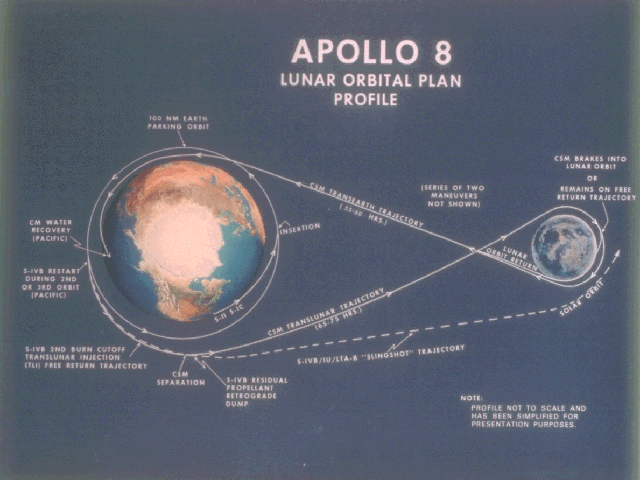
The few privy to the ‘Mission X’ profile agreed that the lunar flight would yield valuable information, and opted to push the limits of the technology and lunar programming software – the guidance and telemetry systems that were responsible for getting the spacecraft there in the first place. The original plan had called for a lunar flyby, a slingshot flight around the moon. But since the crew was going to go all that way, why not put them in orbit around the moon?
With few detractions and much to gain, the decision was made in August of 1968 to send Apollo 8 to the moon, almost two months before the first manned Apollo flight. But this decision was made taking into account only the aspects of the mission that NASA mission control could guarantee. The CSM would be able to go to the moon, but would the booster be ready in time? Was there an appropriate launch and splashdown window? Would a crew be willing to take on a mission with so many unknowns on such short notice? Many other pieces of the puzzle were still wildcards.
German rocket engineer Wernher von Braun needed to be on board for the mission to, quite literally, get off the 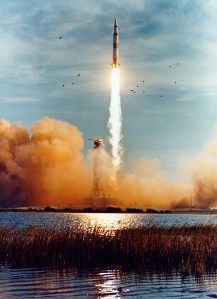 ground. Von Braun’s team had been working towards the development of a new launch vehicle that would be able to send Apollo to the moon, the Saturn V. But in August 1968 it hadn’t yet launched a manned flight. (Left: the 365-foot Saturn V launches Apollo 8 to the moon.)
ground. Von Braun’s team had been working towards the development of a new launch vehicle that would be able to send Apollo to the moon, the Saturn V. But in August 1968 it hadn’t yet launched a manned flight. (Left: the 365-foot Saturn V launches Apollo 8 to the moon.)
The proposed lunar mission excited Von Braun, a longtime proponent of manned space exploration. He accepted the challenge of launching Apollo 8, committing himself and his team to the preparation of a Saturn V in four months that would be man-rated, despite no options for further testing.
Another issue was the preparedness of the crew. Typically, preparation and training for a mission took the better part of a year, the final three months of which allowed the crew to make any last minute adjustments or review any procedures they wanted. Problems in selecting a crew arose because the training schedule reflected the previous mission schedule. With the Apollo 7 crew in training for their C mission, the subsequent crew that would fly on Apollo 8 had been training with the LM for months. They were expecting to fly a D mission. To send them on a mission that negated their previous work was unproductive.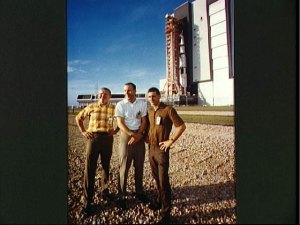
The crew that was in line for Apollo 9, however, had not yet gotten too far into their LM training. They were familiar with the CSM; as a firm staple in the Apollo program, a handful of astronauts had already begun training in simulators. If the Apollo 9 crew accepted the change in mission, they could fast track their training to be ready for a lunar mission in December. (Right: the Apollo 8 prime crew. 1968.)
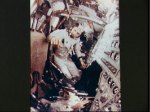 Frank Borman (left) was visiting North American Aviation in Southern California, the company contracted to build the CSM, when he received a call from Deke Slayton urging him to return to Houston immediately. Slayton presented Borman with the basic
Frank Borman (left) was visiting North American Aviation in Southern California, the company contracted to build the CSM, when he received a call from Deke Slayton urging him to return to Houston immediately. Slayton presented Borman with the basic 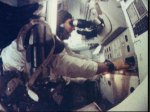 situation, explaining the modified lunar mission that could be his to command. Borman accepted the mission on the spot. If everything worked out he, CM pilot Bill Anders (below), and LM pilot Jim Lovell
situation, explaining the modified lunar mission that could be his to command. Borman accepted the mission on the spot. If everything worked out he, CM pilot Bill Anders (below), and LM pilot Jim Lovell 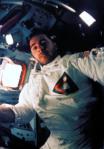 (whose principle role would be as navigator in the absence of an LM, as pictured to the right) would be the first men to make a translunar journey and orbit around another body in the solar system.
(whose principle role would be as navigator in the absence of an LM, as pictured to the right) would be the first men to make a translunar journey and orbit around another body in the solar system.
Apollo 8 had a means to leave the Earth with von Braun’s promise of a Saturn V, and a crew that could pilot the spacecraft to and from its lunar orbital destination. The final piece of the puzzle was how to bring them home. Mission specialists had to determine possible splashdown points. There were two possible landing areas that coincided with the end of year deadline: a possible splashdown point in the Atlantic in December, and an option to splashdown in the Pacific between December 20 and 27.
The Pacific was the ocean of choice – it provided a much larger target area. The problem was that the splashdown window was Christmas, and the Pacific Fleet had already issued stand-down orders over the holidays. As many sailors as possible had been granted leave. Chris Kraft had no choice but to appeal directly to Admiral John McCain, commander in chief of the Pacific Fleet. McCain was sufficiently impressed with Kraft’s presentation that he gave NASA as much Navy support as it needed to ensure the success of Apollo 8.
In September, NASA issued a cryptic news release stating the mission for Apollo 8 would be a high orbital mission with a lunar option in flight. The organization was purposefully secretive in their announcement. Despite the go ahead from the flight directors, the crew, the engineers, and the Navy, the entire mission was dependant on the success of Apollo 7. If there were any significant problems, there was no way NASA would send Apollo 8 to the moon.
Apollo 7 launched on 11 October 1968 for an 11-day shakedown of the CSM. With the lunar orbital plan in the background, Apollo 7’s flight plan was incredibly precise, breaking objectives down into minute parts and keeping the crew busy throughout. The mission was a technical success, effectively starting Apollo 8’s journey to the moon.
Apollo 8 lifted off on December 21, 1968. Following the three-day coast to the moon, the spacecraft entered lunar orbit on Christmas Eve. The crew spent 20 hours in lunar orbit before beginning the three-day journey home. They became the first men to see the Earth in its entirety, capturing the earthrise on film while in lunar orbit. (Below – Earthrise. All three crew members once claimed to have taken the famous picture. According to the timing on the film, NASA determined that Anders had actually taken the shot. Christmas, 1968.)
Suggested Reading/Selected Sources
1. Borman, Frank with Sterling, Robert J. Countdown. Silver Arrow Books: New York. 1988.
2. Kraft, Chris. Flight: My Life in Mission Control. Penguin Putnam. 2002.
3. Kranz, Gene. Failure Is Not an Option. Berkley Books: New York. 2000.
4. Scott, David and Leonov, Alexei. Two Sides of the Moon. Thomas Dunne Books: New York. 2004.
5. Shepard, Alan and Slayton, Deke. Moon Shot. Turner Publishing: Atlanta. 1994.
6. Slayton, Donald K. Deke!. Forge: New York. 1994.

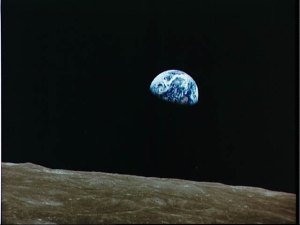
Really nice post. I love the subject matter (all-things space history) and the photos.
I remember listening to the crew of Apollo 8 reading from Genesis on Christmas Eve as if were yesterday; I was 9 and I’ll never forget it.